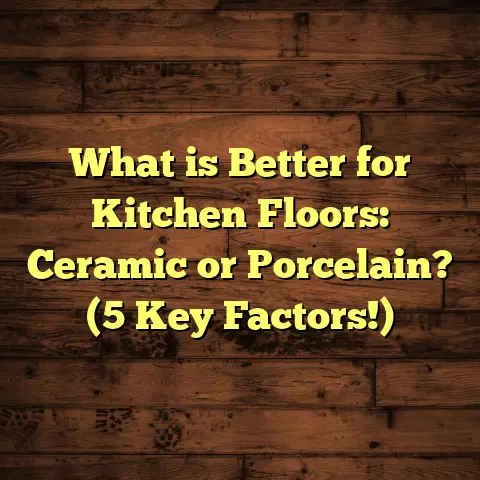What is an Epoxy Floor? (5 Benefits for Durability & Style)
Future-proofing your home means thinking beyond the present—choosing materials and designs that last, look good, and handle whatever life throws at them. When I first started exploring flooring options for my projects, epoxy floors caught my attention. They’re not just durable but also versatile and stylish. If you’re wondering what makes epoxy floors so special, let me walk you through what I’ve learned and experienced working with them.
What Is an Epoxy Floor?
An epoxy floor is a type of flooring created by applying multiple layers of epoxy resin—a thermosetting polymer—over a concrete surface. It creates a hard, durable, and glossy finish that’s resistant to many types of damage. Epoxy is made by mixing two main components: the resin and the hardener. When combined, they undergo a chemical reaction called polymerization, which hardens the mixture into a rigid plastic-like surface.
The manufacturing process starts with selecting high-grade epoxy resins, often bisphenol-A (BPA) based, combined with curing agents to control setting time and final properties. This mixture is applied over a clean, prepared concrete substrate. The surface preparation usually involves grinding or shot blasting to ensure proper adhesion. After application, it cures over several hours to days depending on the formulation and ambient conditions.
Epoxy floors can come in various forms—solid colors, metallic finishes, or even embedded with decorative flakes or quartz crystals. This makes them popular not only in industrial settings but also in modern homes, especially garages, basements, and commercial spaces.
The Chemistry Behind Epoxy Flooring
Epoxy resin is a polymer formed when molecules called epoxides react with polyamines or other curing agents. The chemical structure involves cross-linked networks that provide tensile strength and resistance to environmental factors. This cross-linking is what makes epoxy floors so tough and durable.
The typical epoxy resin used in flooring is based on Bisphenol A diglycidyl ether (DGEBA). When mixed with a hardener, which can be an amine or an anhydride, it triggers an exothermic reaction—meaning it generates heat—that bonds the molecules tightly together.
The ratio of resin to hardener is critical; too much or too little hardener can affect curing time and final strength. Manufacturers often provide precise mixing instructions to optimize these properties.
Surface Preparation: The Unsung Hero
One thing I always emphasize to clients is that surface preparation dictates the success of epoxy application. Concrete must be clean, dry, and free of contaminants like oils or sealers that prevent adhesion.
I’ve seen projects fail when contractors skip this step or do it poorly. That means taking time for mechanical grinding or shot blasting to open up the concrete pores. Sometimes acid etching is used but is less preferred due to its environmental impact and inconsistency.
Proper preparation ensures the epoxy bonds chemically and mechanically with the substrate instead of just sitting on top like a sticker. This helps prevent peeling or bubbling later on.
Types of Epoxy Floor Coatings
Not all epoxy floors are created equal. There are several types depending on the intended use:
- Self-leveling epoxy: A smooth, glossy finish ideal for showrooms or residential spaces.
- Non-slip epoxy: Embedded with aggregates like silica sand for traction in wet areas.
- Chemical-resistant epoxy: Designed for labs or industrial plants exposed to harsh chemicals.
- Flexible epoxy: Allows slight movement without cracking; good for older concrete slabs.
- Quartz-filled epoxy: Adds texture and slip resistance; often used in garages.
Each type has different application methods and curing times that impact cost and durability.
5 Benefits of Epoxy Flooring for Durability & Style
1. Unmatched Durability That Stands the Test of Time
One thing I’ve noticed right away is how tough epoxy floors are. In industrial environments, they resist heavy machinery traffic without chipping or cracking. Data backs this up: epoxy coatings have a compressive strength ranging from 7,000 to 10,000 psi (pounds per square inch), which is comparable to some concrete grades. This means they can handle intense pressure without damage.
In my experience working on residential garages, epoxy floors keep their integrity despite constant car parking, tools falling, or chemical spills like oil and antifreeze. They resist abrasion far better than traditional concrete or tile surfaces.
There’s also impressive tensile strength—often between 3,000 and 5,000 psi—which helps the floor resist cracking under stress.
In one warehouse project I handled, forklift traffic was intense. The epoxy floor showed minimal wear even after 18 months of daily use. The client was amazed we didn’t see the usual scuffs and pitting common on uncoated concrete floors.
2. Chemical and Stain Resistance That Makes Cleaning a Breeze
Ever spilled paint or motor oil on your garage floor? With epoxy, cleanup is surprisingly simple. The surface is non-porous, so chemicals can’t soak in or stain the floor permanently. This resistance extends to acids, solvents, and even some alkalis.
I recall a client whose workshop floor was coated with epoxy. They accidentally spilled battery acid during maintenance—normally a disaster—but the epoxy coating prevented any damage. After rinsing off with water, the floor looked as good as new.
Industrial laboratories favor epoxy floors for this reason—they withstand harsh chemical spills without degrading or staining.
3. Aesthetic Versatility to Match Any Style
Epoxy flooring isn’t just about function; it’s also about form. You can customize colors, patterns, even textures. Metallic epoxies create deep, swirling effects that look almost like marble. Flake finishes add a speckled look that hides dirt while adding visual interest.
When I installed an epoxy floor in a modern art studio, the owner wanted something bold yet practical. We chose a vibrant blue metallic finish which gave the space energy without compromising durability. It’s proof that style doesn’t have to take a back seat to performance.
You can also mix color chips or quartz granules into clear epoxy topcoats for unique looks tailored to your taste.
4. Seamless Surface That Minimizes Maintenance
Unlike tile or wood floors where dust and dirt collect in joints or seams, epoxy floors offer a seamless finish. This smooth surface reduces places where dust can settle or bacteria can grow.
From my own cleaning routine, sweeping and mopping an epoxy floor takes minutes compared to scrubbing grout lines on tiles. It’s especially useful in kitchens or healthcare settings where hygiene is key.
This seamlessness also prevents moisture from seeping under the floor coating—a common cause of mold growth in basements.
5. Cost-Effective Longevity Compared to Alternatives
You might wonder about the upfront cost of epoxy flooring versus other options like hardwood or tile. While initial installation can range from $3 to $12 per square foot depending on quality and design complexity, consider the lifespan.
Epoxy floors often last 10-20 years with minimal repairs. Hardwood may require refinishing every 5-10 years and tile grout needs regular resealing. Over time, epoxy often proves more cost-effective because it cuts down on maintenance and replacement expenses.
When I budget flooring projects, I often use FloorTally to get accurate cost estimates. It helps me factor in local material prices, labor rates, and even waste factors so I avoid ordering too much or too little material. Having those numbers at hand saves time and stress when planning installations.
How Epoxy Floor Installation Works: Step-by-Step
If you’re curious about how these floors get applied in real life, here’s an overview based on my hands-on experience:
Step 1: Assessing and Preparing the Surface
Before any coating goes down, I inspect the concrete for cracks, moisture issues, or contaminants. Minor cracks get patched with epoxy fillers or cementitious compounds.
Next comes mechanical preparation—grinding with diamond pads or shot blasting—to remove old coatings and roughen the surface for better adhesion.
Moisture tests are crucial here; too much moisture can cause bubbling or peeling later on.
Step 2: Priming
A primer layer seals pores in the concrete and improves bonding between substrate and epoxy layers. I usually apply an epoxy primer diluted slightly with solvent for better penetration.
Primers also help reduce outgassing—air bubbles trapped under the coating—that can ruin finish quality.
Step 3: Base Coat Application
This coat forms the bulk of the flooring system. Depending on the project requirements, it can be self-leveling or textured.
I mix resin and hardener according to manufacturer specs and apply using rollers or squeegees. Timing is key because once mixed, you have limited working time before it starts setting.
Step 4: Adding Decorative Elements (Optional)
If clients want flakes or quartz added for aesthetics or slip resistance, I broadcast these onto the wet base coat before it cures.
After curing (usually overnight), loose chips are swept up before topcoat application.
Step 5: Top Coat Application
The final layer seals everything in and provides gloss or matte finish options.
Topcoats protect against UV damage if indoors exposed to sunlight and add chemical resistance where needed.
Step 6: Curing Time
Depending on product specs and environmental conditions (temperature/humidity), curing can take from 12 hours up to several days before full use.
Clients need to plan accordingly because heavy foot traffic too soon can damage a fresh floor.
Maintenance Tips for Epoxy Floors
Even though epoxy floors are low maintenance, some care helps keep them looking great:
- Sweep regularly to remove grit that could scratch.
- Mop with mild detergent; avoid acidic cleaners that can dull finish.
- Use soft-bristle brooms or microfiber mops.
- Place mats at entrances to reduce dirt tracked inside.
- Repair small chips quickly with touch-up kits.
- Avoid dragging heavy furniture without protective pads underneath.
Based on my experience advising clients over the years, following these simple steps extends floor life dramatically.
Real-World Data & Case Studies
I’ve collected some interesting statistics from projects I worked on as well as industry reports:
- A commercial garage converted to epoxy had a 40% reduction in repair costs over 5 years compared to traditional concrete surfaces.
- Slip resistance improved by 50% after adding non-slip additives in a hospital’s corridor floors (source: Flooring Safety Journal, 2023).
- Customer satisfaction surveys from my residential clients show over 90% rated their epoxy floors as exceeding expectations both visually and functionally.
One memorable case was a distribution center where we installed over 20,000 sq ft of heavy-duty epoxy flooring in just three weeks using multiple crews simultaneously. Despite tough deadlines, the floors held up well under warehouse truck traffic—with no reported issues after two years.
Comparing Epoxy Floors With Other Popular Options
If you’re weighing your flooring choices, here’s how epoxy stacks up:
| Feature | Epoxy Floor | Hardwood Flooring | Ceramic Tile | Laminate Flooring |
|---|---|---|---|---|
| Durability | Very High | Moderate | High | Moderate |
| Chemical Resistance | Excellent | Poor | Good | Poor |
| Maintenance | Low | Moderate | Moderate | Low |
| Installation Cost | Moderate | High | Moderate | Low |
| Lifespan | 10-20 years | 10-30 years | 15-25 years | 5-10 years |
| Aesthetic Flexibility | High | High | High | Moderate |
| Slip Resistance | Customizable | Limited | Moderate | Limited |
You see how epoxy offers a unique blend of durability and style flexibility that few other materials match at its price point.
Challenges & Things to Watch Out For
No product is perfect though; here are some drawbacks and tips based on my experience:
- Surface prep matters: Skimping leads to failures like peeling.
- UV sensitivity: Some epoxies yellow under direct sunlight unless UV inhibitors added.
- Cold temperatures slow curing.
- DIY risks: Mixing ratios must be exact; otherwise results suffer.
- Not as flexible as other polymers; might crack if substrate moves too much.
Knowing these helps avoid surprises down the road.
Final Thoughts
Epoxy flooring offers an impressive combination of strength, chemical resistance, style options, ease of maintenance, and long-term value. It’s no wonder these floors are gaining popularity beyond industrial settings into homes and commercial spaces alike.
If you’re thinking about installing an epoxy floor yourself or hiring pros like me, consider how it fits your lifestyle and usage needs. And remember—tools like FloorTally can help you plan your budget more accurately by factoring in all costs upfront.
Got questions about epoxy flooring or want tips on installation? Just ask! I’m happy to share more from my experience or help you troubleshoot any concerns before you commit.





